Stony Brook Assembly
The Stony Brook Assembly was an evangelical organization that held a series of annual summer Bible Conferences and camp meetings in Stony Brook, NY on Long Island from 1909 to 1958. Nationally and internationally known speakers led conferences covering topics on religious, educational, and social reform. The assembly was also the parent organization which founded The Stony Brook School to use its grounds outside of the summer months. Though the assembly dissolved, the school still remains today.
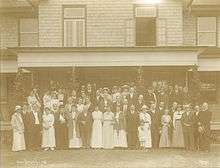
History
Beginning in the late nineteenth century, a number of summer religious retreats and camp meetings were founded following the tradition of the Keswick movement in England and the Chautauqua movement in the United States. Other notable conferences were founded at such places as Chautauqua, NY, Winona Lake, IN, and Northfield, MA, grew in popularity as places of physical rest, entertainment, and spiritual renewal.
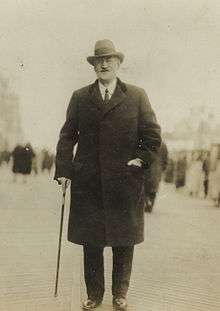
In 1906 a prominent group of predominantly Presbyterian ministers and laymen united to establish a summer Bible conference enterprise in the tri-state area of New York, New Jersey, and Connecticut. The group was led by the Pastor of the Central Presbyterian Church in Brooklyn, NY, the Rev. Dr. John Fleming Carson. Among the handful of sites considered for the endeavor were southern New Jersey and the Poconos, but in 1907, after having visited the north shore of Long Island, Carson settled on the hamlet of Stony Brook. Land was acquired directly across from the Stony Brook branch of the Long Island Rail Road. This allowed easy transportation for the approximately ten million people living in the New York metropolitan area, fifty-five miles away. The nearby Stony Brook harbor could also accommodate sailboats carrying guests from Connecticut and other parts of New England across the Long Island Sound.[1] The first meeting began on July 3, 1909 in a large tent pitched on the lawn of Carson's home on Christian Avenue. Despite the stormy weather, which tore the tent, the conferences were an immediate success. Though the first conference had 707 registered guests, 3,869 people in all were in attendance. By the next summer, an auditorium accommodating 1,000 people was erected on the assembly grounds. At the time it was the largest building on Long Island. Today the auditorium is known as Carson Auditorium.
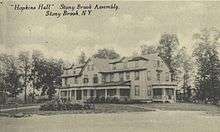
In April 1914, the Assembly was incorporated by the State of New York with the Platform of Principles included in its certificate and bylaws.
In 1915, New York philanthropist Ferdinand T. Hopkins funded the erection of a hotel for conference guests on the assembly grounds. Hopkins Hall stood until it was demolished in 1980.
In 1918, Robert Johnston, vice-president of Scruggs, Vandervoort and Barney department store in St. Louis, Missouri, erected another hotel adjacent to the auditorium.
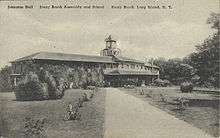
In September 1922, the Directors of the Assembly opened The Stony Brook School for Boys as part of their mission to further Christian scholarship at the secondary level. Frank E. Gaebelein, a recent graduate of Harvard's master's program and the son of perennial conference speaker Arno C. Gaebelein, was chosen as the first headmaster. The Assembly oversaw the governance of the school until the Assembly's dissolution.
Following Billy Graham's 1957 crusade at Madison Square Garden, Frank E. Gaebelein, who chaired the crusade committee, invited Graham to the campus for a follow-up event that September.[2] Many fundamentalist conference-goers objected to Graham's presence on campus because of his broadly ecumenical relationship with other branches of Christianity, including Catholics. That summer, the conferences were suspended and the Assembly was later dissolved. The Stony Brook School retained the property and was rechartered separately from its incorporation under the Assembly.
Purpose
The purpose of the founders of the assembly was to establish a center of religious and educational work in harmony with the Platform of Principles.
In advertising the Assembly in the magazine The Caledonian in March 1909, John Carson explained the reasons why the endeavor of founding the Assembly was undertaken:
"The association has been organized for the purpose of establishing a summer resort to be conducted on lines similar to those of other religious and educational associations, where present-day topics and problems in the religious, educational and civic world will be presented and discussed by the masters of each department. Long Island resorts have been known purely as pleasure resorts with no religious features connected with them except at a small camp meeting of Jamesport. There has been no concerted movement for the establishment of a resort of this kind within easy reach of New York city in the past; and keeping that idea prominently before their minds the members of the assembly came to the conclusion that in what might be called the metropolitan district there are 8,000,000 people, many of whom are going to distant places to find such privileges, felt that the time had arrived to lay the foundations of and establish such a work as it is proposed to do at Stony Brook."
Carson continued explaining the broader purpose of the conferences in addition to their religious focus:
"Ocean Grove puts emphasis distinctly on its camp meetings; the services at Stony Brook, it is projected, shall be on a much larger and broader platform. The proceedings at Northfield and Winona are distinctly spiritual in character and each limited to fifteen days. The Stony Brook program embraces most of the summer and includes the consideration of social questions, political questions in their moral aspects, and educational as well as religious problems, which with the various conferences planned will fully take up the months of July and August."
— John F. Carson[3]
Platform of Principles
Central to the Assembly were a set of seven core doctrinal principles upon which all speakers and directors agreed to adhere. The Platform was drafted at the residence of John F. Carson.
- I. The deity of our Lord Jesus Christ.
- II. The need and efficacy of the sacrifice of the Lord Jesus Christ for the redemption of the world.
- III. The presence and power of the Holy Spirit in the work of redemption.
- IV. The divine institution and mission of the Church.
- V. The divine inspiration, integrity and authority of the Bible
- VI. The broad and binding obligation resting upon the Church for the evangelization of the world.
- VII. The consummation of the Kingdom in the appearing of the glory of the great God and our Saviour Jesus Christ.[4]
Types of Conferences
Conferences typically offered each summer addressed various topics and constituencies, which included:
- I. General Bible Conference
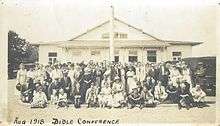 General Bible Conference Aug. 1918
General Bible Conference Aug. 1918 - II. Summer School for Theological Students and Ministers
- III. Conference for Sunday School Workers
- IV. Conference for the study of Prophecy
- V. Evangelistic Conference and Fellowship
- VI. Conference for Students
- VII. An Open Congress
- VIII. Conference for Young People
- IX. Social and Economic Conference
- X. Conference for Public School Teachers[4][5]
Founders of the Assembly
Listed are those who contributed toward the Assembly and were recognized as its founders.
Ministers
Contributing $100[6]
|
|
Laymen
Contributing $100–$2,500[7]
|
|
|
Prominent Conference Speakers
|
|
References
- Lockerbie, D. Bruce (1972). The Way They Should Go. New York: Oxford Press. p. 24.
- "Billy Graham Set For Rally Tonight At Stony Brook". The Patchogue Advance. September 26, 1957. Retrieved 2012-12-30.
- "Great Educational Summer School, Stony Brook, L. I." The Caledonian. Caledonian Publishing Company. VIII (XI): 523. March 1909. Retrieved 30 December 2012.
- "Assembly Brochure circa 1912 pp. 6". The Stony Brook School Archives. Retrieved 2013-01-01.
- "Assembly Brochure circa 1912 pp. 7". The Stony Brook School Archives. Retrieved 2013-01-01.
- "Assembly Brochure circa 1912 pp. 8". The Stony Brook School Archives. Retrieved 2012-11-15.
- "Assembly Brochure circa 1912 pp. 9". The Stony Brook School Archives. Retrieved 2012-11-15.
- "Important Week at Stony Brook". The Long-Islander. August 22, 1919. Retrieved 2012-12-30.
- "Many Noted Preachers At Bible Conference, Stony Brook Assembly". The Patchogue Advance. August 26, 1938. Retrieved 2012-12-30.
- Jenks, Jeremiah W. (July 23, 1910). "The Stony Brook Conference". The Survey. New York: The Charity Organization Society of the City of New York. Retrieved 2013-10-24.
- "The Stony Brook Program". The Long-Islander. August 17, 1923. Retrieved 2012-12-30.
- "Bryan at Stony Brook". The Long-Islander. September 1, 1911. Retrieved 2012-12-30.
- "An Important Religious and Educational Assembly at Our Doors". The Long-Islander. July 8, 1910. Retrieved 2012-12-30.
- "Bible Conference Scheduled For Aug. 23-Sep. 1". The Port Jefferson Echo. March 27, 1930. Retrieved 2012-01-09.
- "Many Prominent Men to Speak At Stony Brook Bible Conclave". The Patchogue Advance. July 17, 1947. Retrieved 2012-12-30.
- "Sacred Prophecy Conference To Open On Aug. 18". The Port Jefferson Echo. August 15, 1929. Retrieved 2012-12-30.
- "Big Suffrage Rally". The Port Jefferson Echo. September 22, 1917. Retrieved 2012-12-30.
- "Chautauqua's New Rival" (PDF). The New York Times. July 3, 1910. Retrieved 2012-12-30.
- "General Conference Stony Brook Assembly". The Long-Islander. August 15, 1924. Retrieved 2012-12-30.
- "Assembly to Hear Jones". County Review. August 5, 1943. Retrieved 2015-02-06.
- "Bible Conference Opens At Stony Brook Sunday". The Patchogue Advance. August 17, 1928. Retrieved 2012-12-30.
- "Six Day Bible Convention Scheduled At Stony Brook". The Long-Islander. July 21, 1960. Retrieved 2012-12-30.
- "Stony Brook Assembly Closes Sessions". The Long-Islander. September 5, 1924. Retrieved 2012-12-30.
- "Great English Preachers At Stony Brook Auditorium". The Port Jefferson Echo. August 25, 1927. Retrieved 2012-12-30.
- "Bible Conference Opens At Stony Brook, Aug. 23". The Port Jefferson Echo. August 14, 1930. Retrieved 2012-12-30.
- "Bible Conference at Stony Brook". Suffolk County News. August 6, 1909. Retrieved Jan 11, 2013.
- "Stony Brook Conference". The Long-Islander. July 14, 1933. Retrieved Jan 7, 2013.
- "Stony Brook Conference". The Port Jefferson Echo. August 12, 1922. Retrieved 2012-12-30.
- "Dr. Munro Is Rally Speaker". The County Review. August 8, 1940. Retrieved 2012-12-30.
- "Internationally-Known Men to Speak At Bible Conference in Stony Brook". The Patchogue Advance. July 21, 1949. Retrieved 2012-12-30.